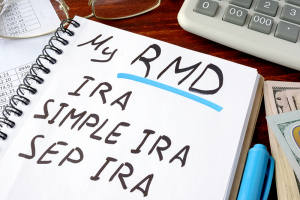What You Don’t Know about RMDs Can (Really) Cost You
By Jim Terwilliger

Thank goodness for pre-tax retirement plans such as 401(k)s and traditional IRAs.
These plans offer attractive features that encourage saving for retirement, including:
• Contributions are pre-tax, resulting in the ability to deduct ongoing contributions from taxable income during one’s working years.
• Plans are portable, resulting in the ability to continue to build a retirement nest egg while working for several employers over a career — a model which is now rapidly becoming the norm.
• Income taxes are deferred until distributions are taken.
Eventually, Uncle Sam wants to collect taxes on the money set aside over the years. Enter the Required Minimum Distribution (RMD), the slow-but-steady distribution of money from these accounts that results in a slow-but-steady payment of income taxes. For workers’ non-inherited plans, this process is initiated at age 70-1/2.
Let’s take a look at some of the details as well as the consequences to the taxpayer if details are not followed.
IRS rules state that an RMD should be calculated for each account separately. Then, where aggregation is allowed, these RMD amounts can be added together and the distribution can be taken in any proportion from one or more of the aggregated accounts.
One of the benefits of IRAs is that RMDs for multiple IRA accounts can be aggregated. Traditional, SEP, and SIMPLE IRAs are treated as a combined group. The RMD is calculated for each account separately, but after that, the RMD amounts can then be added together and taken from any one or combination of accounts.
Surprisingly, the same is true for 403(b) accounts. Aggregation is allowed for RMD purposes across these employer plans.
The same is not true, however, for other employer plans. A taxpayer with multiple 401(k), governmental 457(b) or other similar plans must calculate the RMD for each individual plan and take that RMD from that plan only.
While RMDs are not required for non-inherited Roth IRAs, they are for Roth 401(k)s once the account holder reaches age 70-1/2 and is no longer employed by the company (or is still employed but owns more than 5 percent of the company). Following the 401(k) rule above, Roth 401(k) RMDs cannot be aggregated. The simple way around the RMD dilemma here is to roll the Roth 401(k) over to a Roth IRA, and the RMD requirement disappears.
Any IRA or 403(b) account making a series of substantially equal payments over a period of 10 years or more, or over life expectancy, cannot aggregate that payment with the RMDs from any other like retirement account. The distribution from the account making these payments is considered the RMD from that account only.
Note that an RMD cannot be rolled over from any one account to another account. The RMD is considered to be the first funds distributed from any retirement account during the year. IRA RMDs can, however, be transferred from one account to another. A transfer is when the IRA funds go directly from one financial institution to another. The RMD can then be taken later in the year.
There are two potential penalties when taxpayers make RMD aggregation mistakes — the penalty for excess contributions and the penalty for missed RMDs.
RMDs that are rolled over to another retirement plan create an excess contribution in the receiving account, which must be corrected. An excess contribution can be corrected without penalty by Oct. 15 of the year following the year for which the contribution was made. The amount of the excess plus/(minus) taxable gains/(losses) attributable to the excess must be removed from the account.
Excess contributions that are not corrected on time are subject to a penalty of 6 percent per year for every year they remain in the account. Form 5329 should be filed with the IRA owner’s tax return to report the excess contribution(s) and calculate the penalty, if any.
When a distribution is taken from the wrong type of account due to an aggregation error or the RMD is just not taken at all, this constitutes a missed RMD. The penalty for a missed RMD is a steep one – 50% of the amount not taken.
To rectify the situation, the taxpayer should immediately take the missed RMD, file Form 5329 to report the error, and follow the instructions to request relief.
Making RMD errors is easy to do, particularly when multiple accounts at multiple institutions are involved. Errors can be costly and take time to fix. Working with a trusted financial planner and tax professional is your best bet to stay on the straight and narrow.
James Terwilliger, CFP®, is senior vice president, financial planning officer, Wealth Strategies Group, Canandaigua National Bank & Trust Company. He can be reached at 585-419-0670 ext. 50630 or by email at jterwilliger@cnbank.com.
